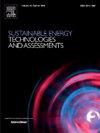Theoretical model and performance study of a stacked hydraulic piezoelectric energy harvester under multiple pulsation frequencies excitation
IF 7.1
2区 工程技术
Q1 ENERGY & FUELS
Sustainable Energy Technologies and Assessments
Pub Date : 2025-03-01
DOI:10.1016/j.seta.2025.104263
引用次数: 0
Abstract
Stacked piezoelectric energy harvesters can be applied to hydraulic systems to convert the pressure pulsation into electrical energy for powering low-power components. A theoretical model is constructed, taking into account the elastic effect of the fluid to mechanical interface. This model is employed to investigate the influence of pulsation frequency excitation on the energy harvesting performance. The findings indicate that the voltage and average power increase with increasing fundamental frequency only at low resistance for single frequency excitation. The harmonic frequency component of pressure is beneficial for improving the harvested electrical energy. When the pressure pulsation contains cavitation high-frequency, the voltage and resistance exhibit a quadratic growth pattern. The increase in fundamental frequency can significantly enhance the voltage and average power of high resistance. Conversely, altering high-frequency affects the energy harvesting performance of low resistance. Furthermore, under small difference between high-frequency and fundamental frequency, the optimal resistance increases initially before decreasing with further increase in the fundamental frequency. However, as this frequency span increases, the effect of the fundamental frequency on the optimal resistance becomes progressively weaker. This paper offers a theoretical practical foundation for selecting fluid regions in hydraulic piezoelectric energy harvesting.
多脉动频率激励下叠置式液压压电能量采集器的理论模型及性能研究
堆叠式压电能量采集器可应用于液压系统,将压力脉动转化为电能,为低功率元件供电。建立了考虑流体对机械界面弹性作用的理论模型。利用该模型研究了脉冲频率激励对能量收集性能的影响。结果表明,只有在单频激励的低电阻情况下,电压和平均功率才随基频的增加而增加。压力的谐波频率分量有利于提高电能的收集。当压力脉动包含高频空化时,电压和电阻呈二次增长模式。基频的增加可以显著提高高电阻的电压和平均功率。相反,改变高频会影响低电阻的能量收集性能。在高频与基频差较小的情况下,随着基频的进一步增加,最佳电阻先增大后减小。然而,随着频率跨度的增加,基频对最佳电阻的影响逐渐减弱。本文为水力压电能量收集中流体区域的选择提供了理论实践基础。
本文章由计算机程序翻译,如有差异,请以英文原文为准。
求助全文
约1分钟内获得全文
求助全文
来源期刊

Sustainable Energy Technologies and Assessments
Energy-Renewable Energy, Sustainability and the Environment
CiteScore
12.70
自引率
12.50%
发文量
1091
期刊介绍:
Encouraging a transition to a sustainable energy future is imperative for our world. Technologies that enable this shift in various sectors like transportation, heating, and power systems are of utmost importance. Sustainable Energy Technologies and Assessments welcomes papers focusing on a range of aspects and levels of technological advancements in energy generation and utilization. The aim is to reduce the negative environmental impact associated with energy production and consumption, spanning from laboratory experiments to real-world applications in the commercial sector.
 求助内容:
求助内容: 应助结果提醒方式:
应助结果提醒方式:


